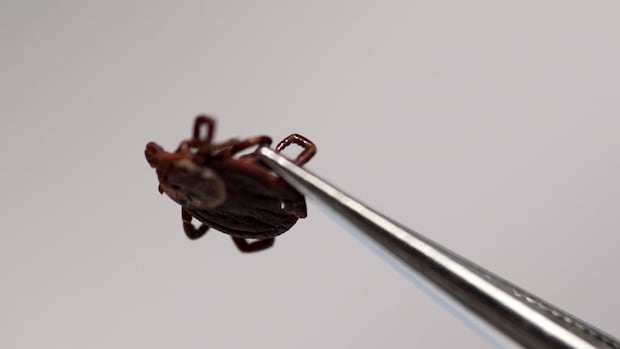“I know it’s not stylish,” admits Nicholas Ogden, “but it actually does prevent the ticks.”
He tucks his pants into his socks, then sprays insect repellant over both.
The scientist is preparing to test a section of Mont-Saint Bruno, a hill in southern Quebec, for ticks — without catching the diseases they carry. Today, he’s got a special eye out for black-legged tick nymphs. At this stage, they’re about as big as a poppy seed, and they’re the most likely suspects carrying bacteria and parasites that cause maladies like Lyme disease, anaplasmosis or babesiosis.
With warmer temperatures, ticks have been taking root in places they never have before. And Ogden, a senior scientist at the Public Health Agency of Canada (PHAC), thinks it’s only going to get worse.
“The studies that we’ve done suggest it still has a way to go. The ticks are still continuing to spread their geographic range,” said Ogden, who has studied ticks for decades.
“What it does show,” he says, “is that climate change is having an impact on our health.”
Now, Canadian scientists are trying to get ahead of the trend — researching new, experimental ways to control tick populations, and calling for new prevention methods.
National tick surveillance
As tick populations have increased, so have the number of people falling ill with tick-borne diseases across Canada, says Dr. Gerald Evans, an infectious diseases expert at Queen’s University in Kingston, Ont.
“We continue to see more and more cases,” he said. “We principally see people with anaplasmosis in the spring, but we do see Lyme disease all throughout the year, but principally in the spring and the summer.”
Negar Elmieh, a scientist with the National Collaborating Centre for Environmental Health, says there’s more that all levels of government can do to comprehensively track tick populations across Canada.
That could include a comprehensive countrywide system that allows scientists to see what ticks are where.
“There’s some of that going on in pockets of Canada, but there’s not a national system of comprehensive tick surveillance,” she said.

Ogden from PHAC said tick surveillance across Canada has already ramped up quite a bit in the past two decades, as tick populations have increased.
According to the health agency’s last report tracking ticks, authorities tracked the arachnids through images or samples collected from people or their pets, submitted voluntarily by members of the public, veterinarians or health-care workers.
The report also looked at the ticks collected from their natural habitat by researchers, through methods like drag sampling (dragging fabric along the forest ground, and seeing what kind of ticks latch on) from 331 sites in 10 provinces.
Through that data, it found that in provinces like Quebec and Ontario, about one in four blacklegged ticks carried the bacteria that causes Lyme disease.
Targeting deer and white footed-mice
Researchers are also looking to curb the tick population by targeting the animals on which they feed.
One system that’s been used in the U.S. focuses on deer. Called a “4-Poster treatment,” it involves strategically placing deer feed near rollers soaked in tick-killing chemicals.
“As the deer are eating, their legs are rubbing against these rollers, which are applying the pesticides to them,” says Elmieh.
Dr. Samir Gupta, a Toronto based respirologist, is warning of an increase in tick bites and tick-borne illnesses across Canada. Ticks are parasites that feed on the blood of wild animals, and are known to transmit bacteria through bites.
However, Ogden says these systems haven’t been effective in every location.
“In some places, very few deer actually come to the feeders, so it depends from one place to another,” Ogden said, citing research from colleagues on the system’s effectiveness in the Maritimes.
“That is why it’s still a research project.”
Quebec is exploring a similar treatment, but targeting mice and other rodents, not deer. Called “reservoir-targeted methods,” it tries to reduce the transmission of the pathogens that cause the diseases among animals like white-footed mice, rats and chipmunks.
That could mean putting bait into a station that contains tick-killing pesticides called acaricides.
“So when a mouse goes in and eats one of those baits, it acquires a dose of acaricide, which gets onto the surface of the mouse and kills the ticks.”
Smart landscaping
Tucking your pants into your socks, using insect repellent like DEET or Icaridin, and thoroughly checking your body for ticks after spending time outdoors are established ways to prevent tick-borne diseases.
Another way people can reduce risk, Elmieh says, is by being smart about how their backyards or recreational areas are set up.
Dr. Lauren Adelman, a veterinarian, internal medicine specialist and co-founder of The Senior Dog Veterinary Society, says she’s been seeing more dogs come into her practice with ticks. She tells BC Today Michelle Eliot owners should give their pets a head-to-toe tick check after walks, and take the animal to a vet if a tick is found.
“Ticks don’t like hard surfaces, so using [hardscaping] material — concrete, rock, wood chips, gravel — is great for walkways and gathering areas, because ticks don’t like to crawl on that.”
Another way to curb tick populations, Elmieh says: pruning trees and bushes and maintaining lawns. That, she says, reduces humidity and increases sunlight, which ticks don’t like. People can also add garden plants that deer and rodents are less likely to be attracted to, like lavender, Russian sage, pennyroyal, irises and daffodils.
“I like to think that we’re smarter than ticks. So I think, you know, if we can work collaboratively, I think there’s a lot that we can do.”









